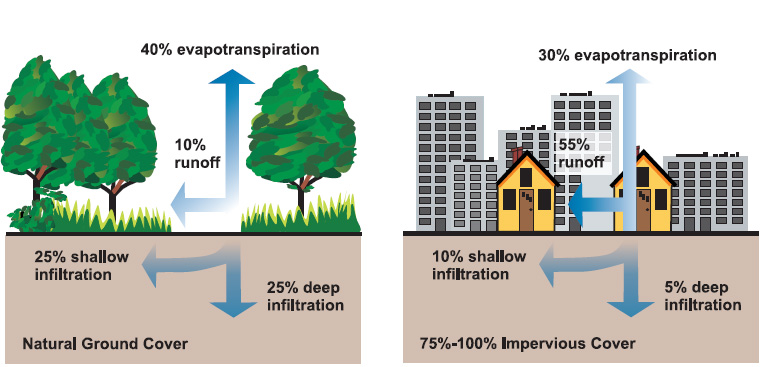 |
| Image and article by Amy Coffman Phillips of The B-Collaborative (cross posted) |
On a stormy day like today, we remember that water - life giving resource that it is - can cause big problems for the built environment! Maybe you are worried about your basement flooding. Or that your car will get stuck as flash floods cover roadways. Maybe you worry about water infiltrating your building, damaging finishes and inviting mold. The question we must ask is: are these problems inherent in the process of development or are they signs that we are managing stormwater incorrectly?
Through biomimicry, we can find innovative solutions to this challenge by asking the question: "how does nature manage stormwater?"
As an architect, one of my primary responsibilities is to "keep water out" of buildings. Often, that means finding ways to accelerate the flow of water off the roof and away from the site. We do this with impermeable surfaces, downspouts, drainage channels, drain tile, and much more. The goal is to get water off and away as soon as possible, treating it as a waste product. But in nature, the strategy is the opposite of acceleration, but to slow the flow. Water is slowed in a many ways at a variety of scales.
Let's think like a forest.
Canopy trees are the first defense: slowing the fast moving water that falls from the sky and breaking it up into smaller droplets. Then understory trees, shrubs, and ground cover further serve to break apart water drops and slow the flow until they fall to the soil and are readily absorbed by spongy soil architecture. Excess water that is not readily absorbed runs off but is impacted by logs, twigs, rocks, and other obstructions that serve to further slow this acceleration. The result is that only a very small percentage of the water that falls from the sky actually runs off to streams and rivers in intact ecosystems.
What a difference from our built environment where over half of the water that falls on site is wasted, taking soil and pollution along with it to clog waterways.
Fortunately, architects, planners, city officials, and politicians are realizing that in the process of developing our cities, we have destroyed native ecosystems and the services they provided. Through biomimicry and the "Genius of Place" process, we can begin to reverse this situation and the negative impacts we have created for ourselves.
It's time to rethink the paradigm of stormwater as a waste product and look to nature for inspiration to make our buildings like trees, our cities like forests.
Discover innovative solutions to this and other challenges at the Chicago Biomimicry Immersion, starting April 25th at The Morton Arboretum! Be sure to enter the promo code "BIOCHI10" for 10% off the cost of registration!
Discover innovative solutions to this and other challenges at the Chicago Biomimicry Immersion, starting April 25th at The Morton Arboretum! Be sure to enter the promo code "BIOCHI10" for 10% off the cost of registration!


No comments:
Post a Comment